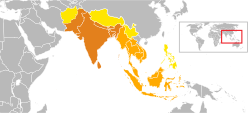Indosphere
Indosphere is a term coined by the linguist
Influence
The

Some languages and cultures firmly belong to one or the other. For example, the
Indian cultural, intellectual, and political influence – especially that of
Structure
Languages in the "Sinosphere" (
Many languages in the western side of the Sino-Tibetan family, which includes the Tibeto-Burman languages, show significant typological resemblances with other languages of South Asia, which puts them in the group of Indosphere. They often have heavier syllables than found in the east, while tone systems, though attested, are not as frequent.[14] Indospheric languages are often toneless and/or highly suffixal.[15] Often there is considerable inflectional morphology, from fully developed case marking systems to extensive pronominal morphology found on the verb. These languages generally mark a number of types of inter-casual relationships and have distinct construction involving verbal auxiliaries.[14] Languages of the Indosphere typically display retroflex stop consonants, postsentential relative clauses and the extended grammaticalization of the verb say.[7] In Indospheric languages, such as the Tibeto-Burman languages of Northeast India and Nepal, for example, the development of relative pronouns and correlative structures as well as of retroflex initial consonants is often found.[5]
See also
- Sanskritisation's key drivers
- Greater India, Indian sphere of cultural influence
- History of Indian influence on Southeast Asia
- Indianisation, in wider global historic and contemporary context
- Sanskrit-related topics
- Mandala, a political model which was key driver of Indosphere
- Other related
- Indian honorifics, influenced the Malaysian, Thai, Filipino and Indonesian honorifics
- Indian Diaspora, ancient (PIO) and current (NRI)
- Siam Devadhiraj
- Sinosphere
References
- ^ ISBN 0-520-09843-9
- ^ ISBN 0-19-920346-6
- ^ JSTOR 415281
- ^ a b RJ LaPolla, The Sino-Tibetan Languages, La Trobe University
- ISBN 978-3-11-019592-7
- ^ ISBN 978-3-11-017841-8. Archived from the original(PDF) on 2017-05-17. Retrieved 2015-11-16.
- OCLC 57054139.
- ISBN 3-11-019592-5
- ISBN 0-684-80617-7
- ISBN 0-19-925591-1
- ISBN 90-272-2985-6
- ISBN 0-19-920783-6
- ^ ISBN 3-11-019303-5
- ISBN 1-902937-06-6
Further reading
- Bradley, David; LaPolla, Randy; Michailovsky, Boyd; and Thurgood, Graham (editors). Language variation: Papers on variation and change in the Sinosphere and in the Indosphere in honour of James A. Matisoff, pp. 113–144. Canberra: Pacific Linguistics.
- Ankerl, Guy (2000) [2000], Global communication without universal civilization, INU societal research, vol. 1: Coexisting contemporary civilizations : Arabo-Muslim, Bharati, Chinese, and Western, Geneva: INU Press, ISBN 2-88155-004-5
